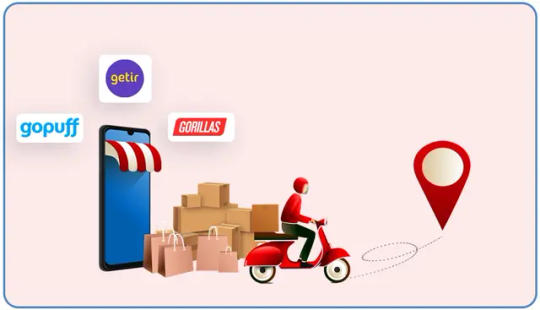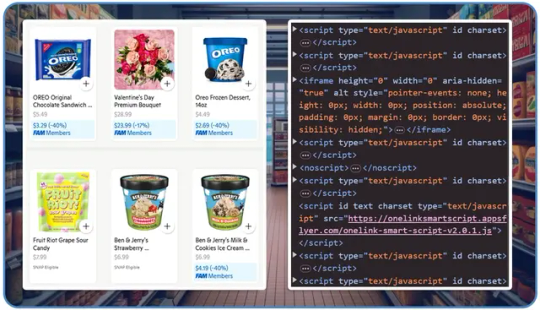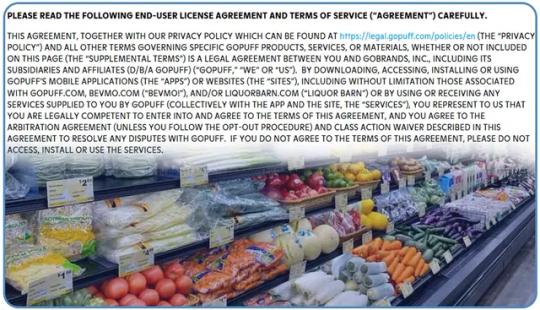#Dynamicpricing
Explore tagged Tumblr posts
Text
Somebody get Mario to shoot the C.E.O. of Ticketmaster for dynamic pricing
12 notes
·
View notes
Text

Stay ahead in the competition with Competitor Price Monitoring, which enables real-time price tracking, strategic decision-making, and business growth.
In this blog, we'll explore why Competitor Price Monitoring is essential, how it helps businesses to track the Competitor Prices, and Pricing Intelligence's role in optimizing pricing strategies. We'll also discuss how Retail Scrape can help businesses implement effective price monitoring solutions.
Read more >>https://www.retailscrape.com/competitor-price-monitoring-essential-insights-and-strategies.php
officially published by https://www.retailscrape.com/.
#CompetitorPriceMonitoring#PriceTracking#PriceIntelligence#CompetitivePricingStrategy#RetailPriceAnalytics#DataDrivenPricingStrategiesForRetail#AIPoweredPriceMonitoringSolutions#PriceOptimizationUsingCompetitorInsights#MonitorCompetitorPricesOnline#RetailPricingTrendsAnalysis#PricingStrategyBasedOnCompetitorData#EcommercePriceMonitoringTools#DynamicPricing
0 notes
Text
How Dynamic Pricing Boosts Event Profits for Organizers?
Dynamic pricing has become a crucial tool for event organizers, not just for airlines and hotels. When used effectively, it boosts early ticket sales, manages demand, and makes events accessible to a wider audience. Solutions like Hytix help organizers implement dynamic pricing strategies to maximize revenue and achieve sold-out events.
#dynamicpricing#ticketingsystem#onlineticket#selltickets#ticketing software#ticketprice#sellticketonline#event ticketing#ticketing system#online event ticket#hytix
1 note
·
View note
Text
Mastering Dynamic Pricing in eCommerce: Stay Competitive, Maximize Revenue
In today’s fast-paced online market, static prices won’t cut it. The key to thriving? Dynamic pricing in eCommerce—where real-time data meets strategic pricing decisions.
In this blog, discover: 📊 What dynamic pricing is and how it works in eCommerce 💡 Popular pricing models used by top brands 🧠 How AI and predictive analytics fuel real-time pricing 💰 Tips to increase conversions and customer loyalty
Whether you're an eCommerce founder, pricing strategist, or digital product manager, this guide helps you stay ahead in a price-sensitive market.
#DynamicPricing#eCommerceGrowth#PricingStrategy#AIinEcommerce#RetailTech#PredictiveAnalytics#SmartPricing#ConversionOptimization#DigitalCommerce#DataDrivenDecisions#KodyTechnolab
0 notes
Text
🍔💸 #SameRestaurant. #SameDish. #Differentprices.

Confused about why food costs vary across Swiggy, Zomato, and Uber Eats? You're not alone.
At Actowiz Solutions, we help brands, aggregators, and restaurant chains scrape and compare real-time menu prices and offer data across major food delivery platforms.
🔍 Here’s what we reveal: ✅ Dish-to-dish price comparisons across apps ✅ Delivery charges & platform service fees ✅ Discount offers & loyalty program tracking ✅ Menu variation by city, region, or PIN code ✅ Customer sentiment linked to pricing behavior
💡 If you're managing a cloud kitchen, a food delivery app, or a restaurant chain—menu price intelligence can shape your entire revenue strategy.
📥 Ready to uncover hidden pricing gaps and smarter market opportunities?
👉 Explore the insights: https://www.actowizsolutions.com/restaurant-menu-price-comparison.php
#RestaurantMenuScraping#FoodDeliveryData#SwiggyVsZomato#uberEatsInsights#PricingIntelligence#MenuPriceTracking#DeliveryPlatformAnalytics#DynamicPricing#web scraping#data extraction#data scraping#data solutions
1 note
·
View note
Text
AI: The FMCG Superpower That Predicts Demand, Prices Smart, and Prints Profit
Imagine a snack brand betting big on a summer festival, only to watch rain-soaked chips pile up in warehouses. Or a retailer slashing energy drink prices, oblivious to a TikTok trend about to send demand through the roof. In the fast-moving consumer goods (FMCG) game, these blunders bleed millions. But here’s the twist: AI is rewriting the rules, turning chaos into cash with razor-sharp demand forecasts and pricing that hits like a bullseye. Buckle up — here’s how AI makes your brand unstoppable.
Why Demand Forecasting Is FMCG’s High-Stakes Poker Game
Every product on the shelf is a gamble. Overstock, and you’re drowning in expired goods. Understock, and you’re kissing revenue goodbye. Old-school methods — spreadsheets, hunches, and a prayer — can’t keep pace with shoppers swayed by viral posts, heatwaves, or a sudden holiday vibe. AI? It’s the card shark that reads the table and stacks the deck in your favor.
Quick Win: AI slashed waste by 22% for a global snack brand in 2024, boosting profits by $4M. Ready to deal your brand in?
How AI Predicts Demand Like a Mind Reader
AI doesn’t just crunch numbers — it’s practically psychic. It gobbles up data from every angle:
Past sales: What flew off shelves last Christmas?
Promos: Did that 2-for-1 deal spark a frenzy?
Regional vibes: Are city folks hooked on artisanal snacks?
Holidays: Is Ramadan driving date sales?
Social buzz: Is a viral reel hyping matcha drinks?
Weather: Will a cold snap spike hot cocoa demand?
Rivals: Are competitors dropping prices?
With cutting-edge algorithms, AI spots patterns and sharpens its predictions daily. Picture this: AI flags a soda sales surge in Goa before a beach rave — weeks before your team clocks it.
Pro Tip: Think of AI as your brand’s weather app, forecasting sales storms and profit sunshine with eerie accuracy.


Pricing That’s Pure Gold
Demand insights are cool, but the real alchemy happens with dynamic pricing. AI digs into:
Price sensitivity: Will a $1 bump scare off buyers?
Inventory health: Too much stock or running on fumes?
Market moves: What’s the competition charging?
Shopper types: Are you selling to deal-seekers or premium fans?
AI then churns out pricing recommendations that nail the trifecta: volume (units sold), margin (profit per unit), and timing (when to tweak prices). This is pricing that flexes by region, channel, and customer.
Case Study Snap: A beverage brand used AI to spot a festival-driven energy drink boom in tier-2 cities. It hiked prices 12% to max margins, while keeping metro prices flat to clear stock. Result? $1.2M in extra profit, no sales lost.
The Payoff: Why FMCG Brands Are Obsessed with AI
When AI runs the show, the wins are epic:
Perfect stock levels: No shortages, no waste.
Sky-high sell-through: Products move before they spoil.
Fatter margins: Cash in on hot items.
Lightning-fast inventory: Keep cash flowing.
Killer promos: Bundles that shoppers can’t resist.

Real-World Domination: AI in Action
Take a national energy drink brand. AI predicts a summer surge in tourist-heavy cities, ramps up production, and sets prices higher in hotspots while trimming them in quieter towns. The kicker? A slick dashboard (think vibrant graphs and regional alerts) keeps the team ahead of the curve. Outcome: Zero missed sales, lean inventory, and a profit spike that had the C-suite dancing.
The Bottom Line: Data Is Your Battle Cry
In FMCG’s dog-eat-dog world, brands that predict and price with precision don’t just win — they dominate. AI isn’t just tech; it’s your war chest, building supply chains that bend, product lines that bank, and prices that keep customers hooked.
Ready to make AI your brand’s secret sauce? At Tech4Biz Solutions, we build AI-powered forecasting and pricing engines that turn FMCG dreams into dollars. Book a free consultation by May 15, 2025, and get a custom AI roadmap worth $5,000 — on us. Don’t wait; your profits won’t.
Stay fierce, stay profitable, stay AI-driven.
#tech4bizsolutions#AIForFMCG#SmartPricing#DemandForecasting#FMCGInnovation#RetailTech#AIinRetail#DynamicPricing#ConsumerInsights#DigitalTransformation
0 notes
Text

✈️ Elevate Your Travel Business with Scriptzol! 🚄🚌
Revolutionize your services using Scriptzol’s advanced tourism solutions – from real-time booking systems to dynamic pricing and personalized itineraries.
Deliver seamless, unforgettable experiences for every traveler! 🌍📲 Visit: www.scriptzol.com
📞 Call: 9943904046 | 📩 [email protected]
#Scriptzol#TravelSolutions#TourismTech#OnlineBooking#DynamicPricing#TravelBusinessGrowth#TravelSoftware#TravelTech#SmartTourism#DigitalTravelPlatform
0 notes
Text
Cracking the Amazon Algorithm: How to Boost Product Visibility and Sales
🛒 Cracking the Amazon Algorithm Isn’t Magic — It’s Strategy
Selling on Amazon? It’s not enough to have a great product. If you’re not showing up in search results or winning the Buy Box, you’re invisible.
Here’s the truth: Amazon’s A10 algorithm doesn’t just care about keywords. It rewards products that convert, delight, and stay in stock.
Here’s how top sellers are playing the game (and winning):
Master keyword intent — Think long-tail phrases, not just broad terms.
Boost conversion rates — Use lifestyle images, videos, and clear bullet points.
Leverage customer reviews — Answer every Q&A and fix pain points before they cost you sales.
Track sales velocity — Run promos to keep momentum going.
Use ecommerce analytics — Tools like 42Signals help you spy on competitors, spot keyword trends, and price smartly.
Real Talk: One skincare brand added customer reviews into A+ Content—saw a 40% boost in clicks. Another bumped up prices by 12% during a competitor’s stock-out—and profits soared.
📈 Want to outsmart the algorithm, not just guess your way through it? This guide breaks it all down → https://bit.ly/4i8CdZI
#ecommerce #amazon #marketingtips #digitalstrategy #42signals

0 notes
Text
How I Saved ₹3,500 on a New Year’s Hotel Booking (and What I Learned About Dynamic Pricing)
I’ve always been a planner when it comes to travel, but this past New Year’s Eve, that habit paid off more than I expected.
If you’ve ever tried booking a hotel for December 31st in a popular destination, you already know how wild the prices can get. But this time, I caught something interesting and super valuable.
Here’s what happened, and why I think everyone in the travel space needs to understand dynamic pricing (especially if you hate paying more for the same room).
Booking Early vs. Booking Late: A Real-World Example

Back in early December, I found a great room at a well-rated hotel with all the good stuff: breakfast included, balcony, garden view, and express check-in. The rate? ₹6,967 per night.
I booked it immediately because I had a feeling prices would spike closer to New Year’s.
Out of curiosity, I went back to the same hotel’s listing on December 31st just to see what had changed.
And boom. The same room, same amenities, same everything, was now ₹10,482.
That’s a jump of over ₹3,500 just for waiting till the last minute.
That’s when it hit me: This isn’t just inflation or a holiday surge; this is dynamic pricing at work.
What Is Dynamic Pricing, Really?
Dynamic pricing is basically a hotel’s way of updating its room rates in real time based on how many people are booking, what time of year it is, and how close the date is. Think of it like this:
Higher demand = Higher price
Lower occupancy = More flexible deals
It’s powered by algorithms and real-time data, and it’s super common now across hotels, flights, and even rental cars.
Why This Matters (Even If You're Not a Revenue Nerd)
Understanding dynamic pricing doesn’t just help hotels make more money; it helps travelers make smarter decisions.
If I hadn’t booked early, I would’ve easily blown my budget just for one night. Knowing how these systems work meant I could plan ahead and save.
And if you're someone who travels often, whether for work or leisure,e this kind of awareness can save you thousands over time.
My Advice?
Book early for high-demand dates. Always.
Set price alerts if you're unsure; many apps now let you do this.
Check prices often; sometimes, discounts get unlocked randomly.
Don’t assume the price is fixed; it probably isn’t.
Dynamic pricing is here to stay, and honestly, I’m glad I caught on when I did.
Have you ever been shocked by a hotel rate jumping overnight? Or scored a crazy deal by being early? I’d love to hear your stories
#traveltech#hotelpricing#bookinghacks#dynamicpricing#smarttravel#hotelstrategy#travelstories#nye2024#hoteltips#budgettravel
0 notes
Text

Tackling Challenges and Embracing Innovation: Dynamic Pricing Kiosks in Retail & Hospitality for middle east and Africa
As digital transformation continues to reshape customer-facing industries, dynamic pricing kiosks are fast becoming a game-changer in sectors like retail, hospitality and food service. These smart kiosks don't just automate the sales process—they offer real-time pricing adjustments, inventory sync and personalized customer interactions.
However, like any evolving technology, they come with their own set of challenges. From integration issues to customer skepticism, businesses must anticipate and manage these hurdles to unlock their full value.
Let’s explore how dynamic pricing kiosks are creating impact, what issues they commonly face and the solutions paving the way forward.
Key Features and Advantages of Dynamic Pricing Kiosks 🕒 Real-Time Price Adjustments One of the most powerful aspects of dynamic pricing kiosks is their ability to automatically update prices based on inventory levels, time of day, demand fluctuations and promotions. Backed by AI algorithms and real-time data, this ensures your pricing is always optimized for both profitability and customer demand.
💡 Enhanced Customer Experience These kiosks enhance the customer journey by:
Displaying clear and accurate pricing
Offering product availability in real-time
Providing a frictionless, self-directed buying experience.
Customers feel more empowered when they have control and transparency—two things these kiosks deliver effortlessly.
💼 Operational Efficiency and Cost Savings Businesses benefit from:
Eliminating manual pricing errors
Reducing the time spent on updates across multiple locations
Saving on labor costs by automating repetitive tasks
The result? A leaner, more responsive pricing strategy with fewer human touchpoints.
Common Challenges Faced by Dynamic Pricing Kiosks ⚠️ System Downtime and Technical Failures Hardware malfunctions, server outages or software bugs can bring kiosks offline, leading to long queues or lost revenue—especially during peak hours.
🤨 Customer Pushback on Dynamic Pricing When pricing varies throughout the day, customers may perceive it as unfair or confusing, especially if the rationale behind the price shift isn’t communicated clearly.
🔄 Integration with Legacy Systems Many businesses still run on older point-of-sale or ERP systems that don’t naturally integrate with modern kiosks, making data synchronization a challenge.
👥 Inadequate Staff Training Without proper training, frontline staff may struggle to troubleshoot kiosk issues or explain dynamic pricing policies, resulting in poor customer experiences.
Solutions to Overcome Common Dynamic Pricing Kiosk Problems 🛠️ Implement Regular Maintenance and Software Updates A well-planned preventive maintenance routine and scheduled software patches are critical to minimizing downtime and maximizing reliability.
🧠 Enhance Customer Education Clear digital messaging on kiosks and in-store signage can explain the benefits of dynamic pricing—such as discounts during off-peak hours—reducing frustration and building trust.
🔌 Seamless Integration Strategies Work with vendors that offer plug-and-play integrations or custom APIs. Prioritize solutions that align with your current IT infrastructure and support cloud-based synchronization.
📚 Training Programs for Staff Invest in comprehensive onboarding and refresher training to equip employees with the knowledge to assist customers, perform basic troubleshooting and reinforce kiosk value.
Trends Shaping the Future of Dynamic Pricing Kiosks 🤖 AI and Machine Learning Integration As AI becomes more advanced, kiosks are evolving from static machines into intelligent agents that predict, learn and adjust pricing based on behavioral data.
📊 Increased Use of Predictive Analytics Businesses are leveraging predictive tools to forecast demand, manage stock levels, and automate promotions—taking dynamic pricing to the next level.
🌱 Emphasis on Eco-Friendly Designs Newer kiosks are being developed with energy-efficient components, recyclable materials and digital receipts, aligning with growing sustainability goals.
Conclusion Dynamic pricing kiosks are more than just digital ordering machines — they're intelligent business tools that combine real-time decision-making, customer convenience and operational efficiency.
Yes, there are challenges, but with the right technology partners, training and strategic planning, these kiosks can deliver incredible ROI while future-proofing your business.
🚀 Is your business ready to embrace dynamic pricing? Let’s discuss how to make the transition smarter and smoother. Drop your thoughts or questions below!
#HospitalityInnovation#SmartKiosks#SelfServiceSolutions#DigitalTransformation#SmartRetail#FoodTech#FutureOfRetail#DynamicPricing#AIinRetail#MachineLearning#IoTDevices#RetailAutomation#PredictiveAnalytics#CloudIntegration#IntelligentSystems#MiddleEastRetail#TechForBusiness#AfricaTech#UAEInnovation#SmartTechMEA#DigitalMEA#CustomerExperience#OperationalEfficiency#CostSavings#BusinessGrowth#RetailStrategy#KioskSolutions
1 note
·
View note
Text
Why Quick Commerce Scraping API Is Key to Maximizing Profits in 2025?

Introduction
Quick commerce businesses encounter significant challenges and opportunities in the fast-paced digital marketplace. With consumer preferences shifting rapidly, pricing dynamics evolving, and competition intensifying, staying ahead requires a data-driven approach that adapts to real-time market changes. As we move through 2025, one solution has emerged as a key driver of sustained growth: the Quick Commerce Scraping API. This advanced tool is revolutionizing how businesses collect market intelligence, refine pricing strategies, and enhance profitability in the quick commerce sector.
Understanding the Quick Commerce Revolution

The quick commerce industry—defined by ultra-fast delivery windows of 10-30 minutes—has dramatically reshaped consumer expectations across retail sectors. Pioneered by industry leaders like Gopuff, Getir, and Gorillas, this market has experienced rapid expansion, with projections estimating it will reach $72.1 billion by 2025.
As competition heats, businesses increasingly seek innovative strategies to secure a competitive advantage. This is where data becomes the ultimate game-changer. The ability to gather, analyze, and leverage real-time market data is critical for Maximize Quick Commerce Profits and staying ahead in an ever-evolving landscape.
The Growing Data Challenge in Quick Commerce

Quick commerce thrives on ultra-fast decision-making and operates within razor-thin margins. To stay competitive, businesses must navigate several key challenges:
Real-time pricing intelligence: Prices fluctuate multiple times a day across various competitors, requiring constant monitoring to maintain a competitive edge.
Product availability tracking: Inventory levels are highly dynamic, and stockouts or restocks can significantly impact sales and customer satisfaction.
Promotional activity monitoring: Flash sales, exclusive discounts, and limited-time offers demand immediate tracking and response to capitalize on market opportunities.
Consumer behavior insights: Understanding rapid shifts in shopping trends and preferences is crucial for personalization and demand forecasting.
Operational efficiency metrics: Effective delivery logistics, inventory flow, and staffing management ensure cost optimization and seamless fulfillment.
By leveraging a Quick Commerce Scraping API, businesses can streamline their market intelligence efforts and gain access to crucial data points that drive competitive pricing, product assortment strategies, and consumer behavior analysis.
What Is a Quick Commerce Scraping API?

A Quick Commerce Scraping API is a powerful automated tool that allows businesses to seamlessly collect and analyze vast amounts of market data from various online sources.
This API efficiently gathers structured data from competitor websites, e-commerce platforms, marketplaces, and even social media channels, providing businesses with real-time insights without the burden of manual data collection.
By leveraging a Quick Commerce Scraping API, businesses can streamline their market intelligence efforts and gain access to crucial data points that drive competitive pricing, product assortment strategies, and consumer behavior analysis.
Key Benefits of a Quick Commerce Data API

Automated data extraction from thousands of online sources ensures comprehensive market trend coverage.
Structured and analysis-ready data outputs, eliminating the need for additional data processing.
Real-time or scheduled data collection lets businesses stay updated with the latest market changes.
Advanced anti-scraping bypass mechanisms, utilizing sophisticated proxy networks to ensure uninterrupted data access.
Compliance with legal and ethical data standards, ensuring responsible and secure data collection practices.
Seamless integration with business intelligence tools enables businesses to effortlessly transform raw data into actionable insights.
By integrating a Quick Commerce Scraping API, companies can unlock deeper market visibility, optimize pricing strategies, and enhance overall business decision-making.
Strategic Applications of Scraping APIs in Quick Commerce

In the fast-paced world of quick commerce, staying ahead requires real-time data insights to optimize pricing, inventory, competitive positioning, marketing, and supply chain operations. Scraping APIs is a powerful tool that enables businesses to make data-driven decisions that enhance profitability and efficiency.
1. Dynamic Pricing Optimization
Price competitiveness in quick commerce is crucial, as consumers frequently compare prices before purchasing. Leveraging a Scraping API For E-Commerce Growth, businesses can track real-time competitor pricing and refine their pricing strategies accordingly.
Case Study: A leading quick grocery delivery platform used scraping API technology to implement dynamic pricing. By adjusting prices based on competitor data, they maintained a competitive edge on high-visibility products while maximizing margins on less price-sensitive items—leading to an 18% profitability boost within three months.
2. Inventory and Assortment Planning
To remain competitive, quick commerce businesses must constantly fine-tune their product mix in response to market trends and consumer demand.
Data Scraping For Quick Commerce Businesses provides actionable insights into:
Trending products across competitor platforms.
Category performance metrics.
Seasonal demand fluctuations.
Stock availability patterns.
Emerging product introductions.
By leveraging these insights, businesses can make informed decisions on inventory investments, discontinue underperforming products, and prioritize new product launches.
3. Competitive Intelligence and Market Positioning
Gaining an in-depth understanding of market trends and competitor movements is essential for strategic planning by:
Track competitor expansion into new geographical areas.
Monitor delivery time variations and service enhancements.
Analyze promotional strategies and marketing messages.
Identify emerging competitors and disruptive market entrants.
Aggregate customer reviews to gauge sentiment.
These insights enable businesses to anticipate competitive shifts and proactively refine their market strategies rather than merely reacting to industry changes.
4. Marketing and Promotional Effectiveness
Promotions are critical in quick commerce, driving customer acquisition and repeat purchases.
Quick Commerce Insights With Scraping API technologies allow businesses to:
Monitor competitor promotional campaigns.
Evaluate the effectiveness of various promotional structures.
Determine the best timing for promotions.
Measure promotional impact across different customer demographics.
Optimize marketing spending through ROI-driven insights.
By leveraging data-driven promotional strategies, businesses can attract and retain customers more effectively while minimizing unnecessary price wars.
5. Supply Chain Optimization
Efficient supply chain management is critical for Profit Optimization Through Scraping APIs. By analyzing competitor product availability, delivery times, and geographical coverage, businesses can:
This enables businesses to:
Identify ideal locations for dark stores and micro-fulfillment centers.
Maintain optimal inventory levels across product categories.
Strengthen supplier relationships based on demand and performance data.
Minimize stockouts and overstock situations.
Enhance logistics planning and improve delivery efficiency.
By refining supply chain operations, businesses can reduce costs while improving service quality—which is essential to maintaining a competitive edge in quick commerce.
How to Implement a Quick Commerce Scraping Strategy?

Implementing a Quick Commerce Scraping API effectively requires a structured approach to ensure valuable insights and actionable outcomes. By following a strategic plan, businesses can maximize the potential of data scraping for competitive advantage.
Identify Key Data Points and Sources
Select the Right API Partner
Establish Data Analysis Frameworks
Create Action Protocols
Measure ROI and Refine Your Approach
Legal and Ethical Considerations

Adhering to legal and ethical standards is essential when integrating data scraping for Quick Commerce businesses to ensure compliance and responsible data usage.
Here’s how businesses can maintain best practices:
Respect Terms of Service: Always ensure that your scraping activities align with website terms of service to avoid potential legal complications.
Manage Server Load: Implement request throttling and efficient crawling techniques to prevent target websites from overloading and ensure sustainable data extraction.
Handle Personal Data Responsibly: Adhere to GDPR, CCPA, and other privacy regulations, ensuring that user data is managed in a compliant and secure manner.
Use Data Ethically: Leverage insights for aggregate market intelligence rather than identifying or targeting specific individuals, maintaining ethical data practices.
Maintain Transparency: Communicate your data collection practices to customers and partners to build trust and ensure compliance.
Partnering with reputable API providers can help businesses navigate legal complexities, reduce risks, and ensure data collection remains within regulatory boundaries.
Future Trends in Quick Commerce Data Intelligence

As we progress through 2024-25, several transformative trends are set to reshape how businesses leverage Quick Commerce Scraping API solutions to maintain a competitive edge:
AI-Powered Analysis: Machine learning will extend beyond data extraction, enabling automated analysis that translates scraped data into meaningful, actionable business insights rather than just raw numbers.
Predictive Capabilities: Advanced scraping systems will provide real-time market data and forecast competitor strategies and industry shifts, allowing businesses to stay proactive.
Integration with IoT: By merging scraped online data with real-time inputs from in-store sensors and connected devices, businesses can gain a more comprehensive view of market dynamics.
Hyper-Personalization: Leveraging collected data, businesses can enhance customer experiences with tailored recommendations, fostering greater engagement, loyalty, and retention.
Cross-Platform Intelligence: APIs will evolve to track data across emerging sales channels—including social commerce and voice commerce—ensuring a well-rounded market analysis.
Businesses that embrace these trends and invest in sophisticated data intelligence will be best positioned to Maximize Quick Commerce Profits in the evolving digital landscape.
How Web Data Crawler Can Help You?

We lead the way in quick commerce data solutions, providing specialized API services tailored to the unique demands of the quick commerce industry. Our platform empowers businesses to develop quick commerce profit strategies through advanced data collection and analysis.
With us, you gain access to:
Custom-built APIs designed for quick commerce data needs.
Advanced proxy networks for seamless and reliable data extraction.
AI-powered data cleaning and normalization for accurate insights.
Real-time competitive intelligence dashboards to track market trends.
Seamless integration with significant business intelligence platforms.
A compliance-focused approach to ethical data collection.
Dedicated support from quick commerce data specialists.
Our solutions have driven success for quick commerce businesses across various sectors, enhancing pricing optimization, inventory management, and competitive positioning.
By leveraging Quick Commerce Insights With Scraping API technology, clients typically achieve 15-25% profit improvements within just six months of implementation.
Conclusion
In the fast-paced, quick commerce industry, data-driven decision-making is crucial for success. A Quick Commerce Scraping API empowers businesses with actionable pricing, inventory, marketing, and operations insights.
Explore how our tailored solutions can enhance your market intelligence. Our experts analyze your challenges and craft custom data solutions to sharpen your competitive edge.
Contact Web Data Crawler today to see how our Quick Commerce Scraping API can fuel your growth in 2025. Stay ahead in the data intelligence race—turn market data into your competitive advantage!
Originally published at https://www.webdatacrawler.com.
#QuickCommerce#EcommerceData#WebScraping#DataIntelligence#MarketTrends#CompetitiveAnalysis#DynamicPricing#RetailTech#AIData#BigData#BusinessGrowth#PriceMonitoring#DataDriven#RetailAnalytics#APIIntegration#DataScraping#QuickCommerceAPI#WebDataCrawler#EcommerceInsights#SmartPricing#SupplyChainOptimization
0 notes
Text
Holi 2025 Bus Travel Demand: Insights from Competition Intelligence and Dynamic Pricing
Holi, the festival of colors, is celebrated all over India with great enthusiasm. It is also a time when people working away from home travel back to their hometowns to celebrate with family and friends. This seasonal migration leads to a surge in passenger movement across cities, significantly impacting travel demand.
This study analyzes bus travel demand during Holi 2025 by comparing it with pre-Holi travel, Holi 2024 travel patterns, and normal, non-event travel periods. Through this analysis, we aim to understand shifts in passenger demand, pricing trends, and revenue impact to aid better decision-making for bus operators
One of the key aspects of this analysis is competition intelligence—understanding how bus operators adjust their pricing and availability in response to fluctuating demand. Additionally, dynamic pricing plays a crucial role in revenue optimization, allowing operators to adjust ticket prices in real-time based on demand surges. By leveraging these strategies, bus companies can maximize profits while ensuring competitive pricing.
0 notes
Text
5 Ways Eric Albuja Leverages Big Data to Enhance Travel Experiences
Eric Albuja, a leader in travel technology, leverages big data to enhance travel experiences through AI-driven personalization, real-time pricing, proactive customer support, safety analytics, and operational efficiency. By harnessing data insights, he ensures seamless, cost-effective, and secure journeys for travelers worldwide.
#EricAlbuja#TravelTech#BigData#SmartTravel#AIinTravel#TechInnovation#FutureOfTravel#TravelSolutions#DynamicPricing#SeamlessTravel#TravelSafety#DataDriven
0 notes
Text
How Does Dynamic Pricing Actually Work in the Hotel Industry?
No, it's not just about raising rates during peak season. It's about using real-time data, market demand, competitor pricing, and guest behavior to make smart pricing decisions—every single day.
In this blog, we unpack: 🔹 What dynamic pricing is & why it’s crucial 🔹 How hotels use AI & algorithms to optimize rates 🔹 Real-world examples that boost revenue 🔹 Tools & technologies reshaping hotel revenue strategy
💡 Whether you're a hotel owner, hospitality consultant, or revenue manager, this blog gives you the insights to price like a pro and stay competitive in 2025
#HotelTech#DynamicPricing#HospitalityStrategy#RevenueManagement#HotelRevenue#AIinHospitality#HotelMarketing#KodyTechnolab#TravelTech#SmartPricing
0 notes
Text

Use Cases of Artificial Intelligence in E-Commerce
Artificial Intelligence (AI) is revolutionizing the e-commerce industry by enhancing customer experiences and streamlining operations. AI-driven personalization allows retailers to offer tailored product recommendations, increasing customer satisfaction and sales. Chatbots powered by AI provide 24/7 customer support, handling inquiries and boosting engagement. Inventory management systems use AI to predict demand, optimizing stock levels and reducing costs. Fraud detection is another critical use, where AI identifies suspicious transactions in real-time. Lastly, AI-driven pricing strategies help businesses adjust prices dynamically based on market trends. USM Business Systems is the best mobile app development company to integrate AI solutions into your e-commerce platform.
#AIinECommerce#ArtificialIntelligence#ECommerceInnovation#SmartShopping#AIPoweredRetail#PersonalizedShopping#AICustomerExperience#ECommerceSolutions#AIRecommendations#FraudDetectionAI#ChatbotsInRetail#DynamicPricing#AIInSales#ECommerceAutomation#AIDrivenBusiness
0 notes
Text
Why Booking Flights Early Isn’t Always Cheaper
For cheap and best Travel Diaries - https://travelinternationals.com/
When planning a trip, it’s often assumed that booking flights well in advance guarantees the lowest prices. However, this common travel tip isn’t always foolproof. Here are some reasons why booking flights early might not always save you money and how you can optimize your travel budget instead.
Airlines Adjust Prices Dynamically
Airlines use complex algorithms to determine ticket prices based on demand, competition, and even historical booking data. When a flight is first made available, prices may start high to gauge initial interest. If demand is lower than expected, prices may drop as the departure date approaches to fill empty seats.
Special Deals and Flash Sales
Airlines often run promotions, flash sales, or offer discounted fares closer to the departure date. These deals may target last-minute travelers or coincide with specific seasons, making it worthwhile to keep an eye on ticket prices even after your initial search.
Seasonality and Travel Trends
Popular travel seasons, holidays, and events can affect pricing. While booking early for peak seasons might be advantageous, the same doesn’t apply for less busy times of the year. Airlines might lower prices closer to the date to encourage bookings if a flight isn’t filling up.
Hidden Costs and Restrictions
Early bird tickets sometimes come with limitations, such as non-refundable clauses or rigid change policies. Travelers who book early might also miss out on bundled deals or packages that become available closer to the departure date, which could offer better overall value.
Tips to Get the Best Deals
Set Price Alerts: Use fare-tracking tools to monitor fluctuations in ticket prices.
Be Flexible: Consider alternative dates or nearby airports to snag better rates.
Research: Check for promotional events or off-peak travel options.
Book Strategically: For domestic flights, the sweet spot is often 1–3 months before departure, while international flights may be cheaper 2–6 months in advance.
Booking flights early isn’t a one-size-fits-all strategy. By understanding how airline pricing works and leveraging tools like fare alerts, you can secure the best deals without breaking the bank
#TravelTips#FlightBooking#CheapFlights#TravelHacks#AirlineTickets#FlightDeals#BudgetTravel#LastMinuteTravel#DynamicPricing#TravelDiaries
0 notes